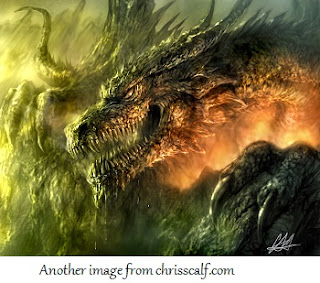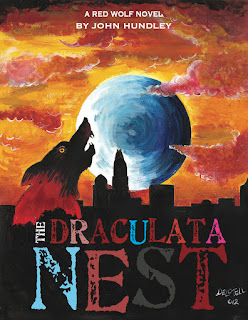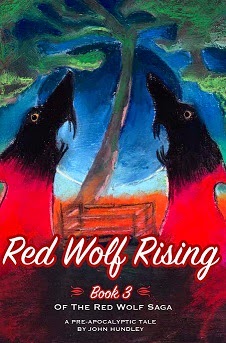History of The Dragon, Part 2
Hi, folks. I’m late again. I’m afraid that’s
going to be the rule rather than the exception while I approach the deadline
for Red Wolf Rising. I’m committed to
getting the third Red Wolf novel out this Spring, so that’s where my priorities
lie until then. Thanks for your patience.
In trying to make the most of my writing time,
the historical narrative I’m currently posting serves a dual purpose. The story
of The Dragon (aka Pieter, aka Dr. Nigel Petros) provides insightful background
material for the Red Wolf saga and readers may find it interesting taking that
knowledge into the next two books, Red
Wolf Rising and Rivers of Red.
But I’m also trying to establish a stronger foundation for the next planned
series (the Half Human saga), which is centered around Pieter’s quest to
reunite with his kind and perhaps reclaim his crown.
But first…
What I’m Currently
Reading…
I finally finished Douglas Preston and Lincoln
Child’s Brimstone. To be honest, I got a little tired of Agent Pendergast’s Sherlock-like
sleuthing towards the end, and I even found the cliff-hanger ending a bit
anti-climactic. Still, I had to give it four stars, because the writing is
excellent and it was rewarding to read a well-edited novel after a string of
books I’ve come across that didn’t seem to have been edited at all. I’ll
definitely read the next few books in the series.
And now I’m delighted to be back in my favorite
genre. I’m well into Frost Burned, by
Patricia Briggs, the seventh book in her Mercy Thompson series. You might
remember this series was number four on my Top Five Paranormal Countdown. I
thought the books about this shape-shifting coyote raised by werewolves started
to go downhill after Mercy chose a mate, but I felt I owed both her and Briggs
another chance. My perseverance has been vindicated. Frost Burned is non-stop action from the get-go.
One of the things I like about Brigg’s werewolf
universe is that she occasionally mixes characters from her Alpha and Omega
series in with the Mercy Thompson books (and vice versa). She’s got one of my
favorite minor characters from Cry Wolf
reprised in this one, Asil, the Moor. Great stuff.
Okay, let’s see now. Last week’s post covered
all the pre-historical background and brought us forward to the time when the
Fae had decided to create vampires in an attempt to destroy mankind. A small
group of dissenters, led by Pieter, who had abdicated the dragon throne over
the issue, had decided to approach mankind with an offer of help.
History of The Dragon,
Part 2…
Although Pieter and his followers all agreed in
wanting to help mankind, they faced a number of obstacles in coming together on
how that should happen, the biggest of which was a lack of time. The Fae are
never ones to make hasty decisions. The plan to create vampires came to
fruition only after several millenia of debate. Pieter’s counter-plan to fight
them was developed and implemented in under five hundred years. That’s hasty by
any Fae standard. Still, it was almost too little and too late.
The Fae unleashed the first vampires on an
unsuspecting population around 12,000 BCE. The undead succeeded in killing or
turning a significant percentage of humanity within a few centuries. Had mankind
not been spread out so thinly across the globe at the time, they would certainly
have been destroyed. As it was, many large groups were completely wiped out,
significantly slowing the advance of human civilization.
Such was the climate when, sometime around
11,850 BCE, Pieter and two of his dragon allies approached one of the early
Mesolithic peoples in what is now the Ukraine looking for volunteers to
participate in a desperate experiment. It turned out to be a hard sell.
First contact didn’t go well. The dragons thoughtlessly
approached the hunter-gatherers while in their true forms. Dragons being the
stuff of nightmares, as you can imagine, these primitive people reacted with
fear and aggression. Subsequent attempts at contact in the guise of human form
resulted in better communication, but the vampiric plague had not yet reached this
section of the globe. The clans were reluctant to rally against a foe they knew
nothing of. Generations of humans came and went with no volunteers.
But the dragons kept at it. They planted the
seed. And when the first vampires eventually appeared in the Ukraine, people
recognized them for what they were. The legends and superstitions became a
reality. Finally, the dragons found an audience willing to listen.
The greatest caveat in determining the plan to
create the vampires was the elves’ insistence that the Fae not get their own
hands dirty in the process of mankind’s destruction. Vampires fit the bill
perfectly, since once created, the Fae could step back and watch the deed be
done. They wanted as little contact with humans as possible. Pieter’s group was
no exception to that rule.
Pieter’s plan called for as little intervention
in day-to-day human affairs as possible. What he offered the humans was a way
for them to help themselves. While the vampires were a result of dark Fae magic,
Pieter wanted to “lend” some light Fae magic to what he already regarded as
humanity’s greatest strengths, the ability to quickly reproduce and evolve.1
He proposed to allow selected humans to draw
upon the strengths and abilities of some of the powerful beasts around them,
giving them the power, when needed, to transform into a supernatural creature
capable of fighting and destroying a vampire.
The names of the first volunteers to participate
in Pieter’s experiment are lost to antiquity, but they all came from a single
clan that controlled a large territory carved out through many generations of
strong leadership. These people revered the wolf over all other animals. It was
the totem of their clan, and they insisted on choosing that animal from which
to draw the strength and cunning they would need to protect themselves from the
vampiric threat.
Pieter later admitted he had a more simian
creature in mind, but the willingness and cooperation of the volunteers was
essential to his plan, so he acquiesced to their choice. The first werewolves
appeared on the scene around 11,700 BCE. They went after the undead with a
vengeance, and vampires quickly disappeared from the Ukraine.
Unlike Vampirism, which is spread by the bite of
a vampire, Lycanthropy is an inherited trait triggered by environmental
factors, such as the presence of vampires, the bite of another werewolf, or
simply the presence of a significant number of other werewolves (i.e, a pack).
The first werewolves were encouraged to spread their seed far and wide, and
given that they were gifted with thousand-year life spans, the Lycanthropic
gene spread throughout the human population relatively quickly. By 8,000 BCE,
the tide of vampirism had been turned.
Pieter’s plan had proven successful, but his
satisfaction was short lived. He and his followers were ostracized by the other
Fae for what they’d done. He continued to defend his actions, advocating for
humanity at every turn and insisting that his peers would soon see the benefits
of human survival as mankind evolved into something more worthwhile.
Problem was, mankind provided no evidence to
back up Pieter’s arguments. In fact,
they only continued to support the worst fears the Fae had about them. The
Neolithic Revolution saw the advent of agriculture, which had a two-fold effect
on the Fae. The number of humans on the planet increased exponentially as their
food source became more readily available. And, particularly for those of the
Fae for whom magic was drawn from the natural flora of their chosen planet,
agriculture sucked the magic from their very being.
By the time the first civilizations began to
arise in lower Mesopotamia (around 3500 BCE), things had gotten so bad for the
Fae they decided to leave Earth. The next five hundred years saw a mass
emigration that is estimated to have reduced their population on Earth by almost
90%.
Pieter’s name had become synonymous with
hopelessness, failure, and treason. When the dragons decided to join the exodus
from the planet, Pieter was not invited to go with them.
It is unlikely he would have joined them in any
case. He had committed himself whole-heartedly to the cause of mankind. He
wanted to see the future he imagined for them come to fruition. Since the
werewolves had succeeded in all but eliminating the scourge of vampirism, he
should have been able to retire to another realm and monitor the progress of
mankind from a safe distance, as he’d originally planned.
But something happened to change his mind.
1 Debate continues among human and Fae
alike as to the ability of the Fae to evolve. Some groups contend that, given
the nature of life itself, Fae evolution must occur, that we cannot see the
evidence of it due to the longevity of individuals. However, there is no
documented scientific evidence of mutation in the existing gene pool or in the
scant fossil record.
We’ll continue to track Pieter’s activities and
conflicts into modern times with the next post. Be on the lookout.
Until then… Happy Reading!
----------------
My Books
The Draculata Nest -----------------------------------------------------------------------
Click on the link to order:
The Dragon of Doughton Park ----------------------------------------------------------
Click on the link to order:
ebook for Kindle in Paperback
ebook for Nook in Charlotte
ebook for Kobo Smashwords
ebook for Kindle in Paperback










Comments
Post a Comment